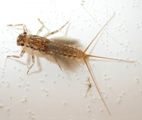Today marks a historic event for California rivers: the launch of the biggest dam removal project in state history.
Over the next 28 months, the beautiful Carmel River will be set free to flow more naturally for 70 percent of its length as the 106-foot (32.3 meter) San Clemente Dam is dismantled.

San Clemente Dam in California, now coming down. Photo via sanclementedamremoval.org
Downstream of the dam, threatened fish and frogs will get a new lease on life as critical habitats open up. And some 1,500 households will enjoy greater safety as the dam’s risk of failure during a major earthquake or flood event disappears.
Built in 1921 to store drinking water for the burgeoning population of Monterey County, the San Clemente Dam is a concrete arch structure located 18.5 miles (29.8 kilometers) upstream from the Pacific Ocean.
While built for a good cause, the dam’s reservoir has lost 95 percent of its original water storage capacity due to the build-up of silt and sediment carried in by the Carmel River. Historically, the river carried that sediment load downstream, keeping its channel functioning well and replenishing coastal beaches. But the dam trapped the sediment in the reservoir, causing it to fill – a common problem with dams worldwide.

San Clemente Creek, where the Carmel River will be routed while the dam is taken out. Photo via sanclementedamremoval.org
The Monterey Peninsula now relies primarily on groundwater for its drinking water supply.
Meanwhile, the dam became a safety hazard as its risk of failure increased. After the state of California’s division on dam safety declared San Clemente “seismically unsafe,” California American Water, the public utility that owns the dam, assessed its options for reducing the dam’s threats. Taking into account cost, environmental benefits and other factors, the idea of tearing the dam down rose to the top of the list.
The project will open up 25 contiguous miles of unimpaired spawning and rearing habitat for a threatened run of steelhead trout. Like salmon, steelhead spend most of their lives in the ocean but move upstream to spawn and grow in coastal rivers and streams. Big dams like San Clemente block their migration and destroy their habitats.
Over the decades, the combination of dams, diversions, and urban development has caused the population of steelhead to plummet. In 1997, federal officials listed the fish as threatened.
For steelhead on the central California coast, “removing this dam is the single best thing you can do for their recovery,” says Samuel P. Schuchat, Executive Officer of the California State Coastal Conservancy.
The dam removal will also restore the natural movement of sediment downstream toward the sea, replenish sand on Carmel Beach, and improve habitat for the California Red-Legged frog, the largest native frog in the western United States and now federally listed as threatened, as well.
The Carmel too will enjoy a revival.
In a gentle ode to the river, John Steinbeck wrote in his classic 1945 work, Cannery Row: “The Carmel is a lovely little river. It isn’t very long but in its course it has everything a river should have.”
Indeed, over its 36-mile run from the Santa Lucia Mountains to the sea, the Carmel flows through a diverse array of habitats, from mixed evergreen forests and montane chaparral to coastal prairie and sand dunes.
The first stage of the project involves some innovative engineering to re-route the Carmel River into San Clemente Creek so that the sediment behind the dam can be stabilized to remain safely in place. The re-routing will allow the river to resume its more natural, pre-dam flow to the sea.
Once the river is diverted away from the sediment-filled reservoir, dismantling of the dam will begin.
The $83 million project has garnered a wide range of support, including that of the conservation groups American Rivers, the Carmel River Watershed Conservancy, the Nature Conservancy, and Trout Unlimited, as well as the federal Bureau of Reclamation and Fish & Wildlife Service, among others.
California American Water, the dam owner, will pay $49 million of the total cost; the California State Coastal Conservancy and the National Marine Fisheries Service will raise the additional $34 million through public and private sources. The Nature Conservancy is contributing $1 million to the project.

San Clemente Dam under construction in 1921. Photo via sanclementedamremoval.org
In addition, California American Water is donating 928 acres (375 hectares) of property around the dam to the federal Bureau of Land Management, which in turn is working with the Monterey parks district to develop recreational trails for use by the public.
If all goes according to plan, both the project’s ecological engineering features as well as its public-private partnership may serve as a model for other river restoration efforts across the state and nation.
“This is an opportunity to essentially restore an entire river system from top to bottom,” says Schuchat of the state coastal conservancy.
“You take the dam out and suddenly you’ve got a natural free-flowing river again – and that’s just really exciting. “
Sandra Postel is director of the Global Water Policy Project and Freshwater Fellow of the National Geographic Society. She is co-creator of Change the Course, the national freshwater conservation and restoration campaign being piloted in the Colorado River Basin.
 Original story at WetlandCare Australia: Helping Hands Improve Wetland Habitat at Pasturage Reserve
Original story at WetlandCare Australia: Helping Hands Improve Wetland Habitat at Pasturage Reserve














